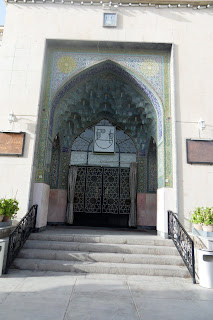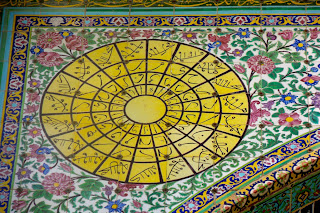When I meet people in Iran, they all start with an interrogation to figure out who I am and what I am doing in Iran. They are incredibly curious at this foreign woman in Iran who at first glance could pass for an Iranian, but has a funny accent when she speaks Persian and is obviously from some faraway country. In the past two months and a half months that I have been in Iran, I have met a lot of people from every walk of life - from university professors to taxi drivers. Almost everyone asks me the same questions in the same order, including one question which I am incredibly uncomfortable with.
It goes something like this:
Question number one: "Where are you from?"
Answer: Amreeka
Question number two: "Are you Muslim?
Answer: Yes
Question number three: "Sunni or Shi'i?"
Answer: Uhhh, it's a long story...
Question number four: Are you married or single" - with lots more questions about my personal living circumstances...
...and so on, until the questions get very personal, onto how much rent I pay per month in the US, where I bought my clothes and how much they cost, and what my parents do for a living.
I never felt particularly "Sunni" until I came to Iran, but I have come to embrace my "Sunni-ness" as a mode of defense as a religious minority and in the face of multiple verbal attacks/criticisms I have faced in Iran for my particular religious beliefs and practices.
In places like Egypt, where I lived for a long time, no one ever asked me if I was Sunni or Shi'i, I was just Muslim as was everyone else although it goes without saying that most Egyptians follow some variation of Sunni Islam. The kind of Islam I practice is similar to the kind found in Egypt, an Islam that includes love of ahl al-bayt and self-identification as a Muslim, but not specifically Sunni, rather just Muslim. Muslims in the US don't tend to ask each other about their denominational affiliations either, so undergoing constant interrogation about my specific beliefs really unsettled me.
While Sunnis are a majority among Muslims, Shi'is are a minority making up only about 10% of the total Muslim population in the world. They are profoundly aware of their minority status among other Muslim-majority countries and make sure that Iranian non-Shi'is are aware of their minority status in Iran.
During the first few weeks in Iran, I prayed with my hands at my sides, which is a practice of Shi'i Muslims, Sunnis pray with one hand on top of the other, either on their chest or stomach ara. I told myself it was ok to practice dissimulation, or taqiyyah, in order to avoid any confrontation, besides in the Sunni Maliki school of law, madhhab, there is a choice to pray with one's hands up or to the side. When I arrived in Iran, I really had no idea about the current situation there, and so took many precautions, perhaps sometimes more than necessary, before I felt comfortable in the country and understood local customs and traditions...
It goes something like this:
Question number one: "Where are you from?"
Answer: Amreeka
Question number two: "Are you Muslim?
Answer: Yes
Question number three: "Sunni or Shi'i?"
Answer: Uhhh, it's a long story...
Question number four: Are you married or single" - with lots more questions about my personal living circumstances...
...and so on, until the questions get very personal, onto how much rent I pay per month in the US, where I bought my clothes and how much they cost, and what my parents do for a living.
I never felt particularly "Sunni" until I came to Iran, but I have come to embrace my "Sunni-ness" as a mode of defense as a religious minority and in the face of multiple verbal attacks/criticisms I have faced in Iran for my particular religious beliefs and practices.
In places like Egypt, where I lived for a long time, no one ever asked me if I was Sunni or Shi'i, I was just Muslim as was everyone else although it goes without saying that most Egyptians follow some variation of Sunni Islam. The kind of Islam I practice is similar to the kind found in Egypt, an Islam that includes love of ahl al-bayt and self-identification as a Muslim, but not specifically Sunni, rather just Muslim. Muslims in the US don't tend to ask each other about their denominational affiliations either, so undergoing constant interrogation about my specific beliefs really unsettled me.
While Sunnis are a majority among Muslims, Shi'is are a minority making up only about 10% of the total Muslim population in the world. They are profoundly aware of their minority status among other Muslim-majority countries and make sure that Iranian non-Shi'is are aware of their minority status in Iran.
During the first few weeks in Iran, I prayed with my hands at my sides, which is a practice of Shi'i Muslims, Sunnis pray with one hand on top of the other, either on their chest or stomach ara. I told myself it was ok to practice dissimulation, or taqiyyah, in order to avoid any confrontation, besides in the Sunni Maliki school of law, madhhab, there is a choice to pray with one's hands up or to the side. When I arrived in Iran, I really had no idea about the current situation there, and so took many precautions, perhaps sometimes more than necessary, before I felt comfortable in the country and understood local customs and traditions...

























